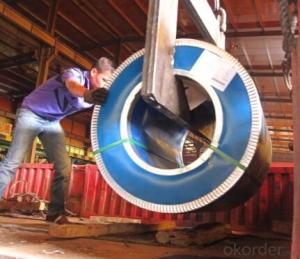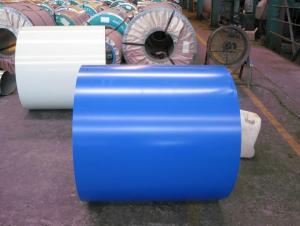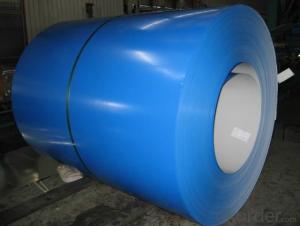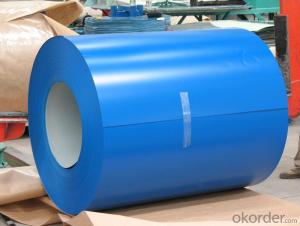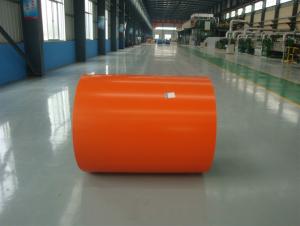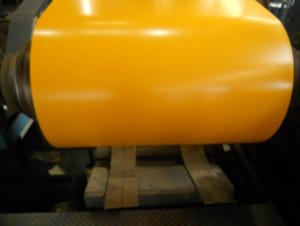Pre-painted Aluzinc Steel Coils Color Coated for Wholesales
- Loading Port:
- Tianjin
- Payment Terms:
- TT OR LC
- Min Order Qty:
- 10 m.t.
- Supply Capability:
- 1000 m.t./month
OKorder Service Pledge
OKorder Financial Service
You Might Also Like
1.Description of Pre-painted Aluzinc Steel Coils:
Galvanized steel coil can be used outside because of its natural ability to avoid rust or corrosion. The coil itself is usually available in different dimensions. It may range from from 6 inches to 24 inches wide (15 cm to 51 cm), and up to 10 feet (3 m) long when rolled out flat.
2.Attentions in transportation and storage :
1)PPGI/PPGL should be stored in neat and tidy environment to avoid possible corrosion caused by all kinds of corrosive medium.
2)The ground for storage should be flat, without hard object, and with sufficient loading-bearing capacity.
3)Storage environment should be dry and ventilated. Avoiding storing outdoors or with dew or with wide temp difference.
4)Coil could not be dragged lest the burr caused by slicing will scratch the coil surface underneath. Coil should be handled with care, without hitting any hard objects.
3.Photo of Pre-painted Aluzinc Steel Coils:
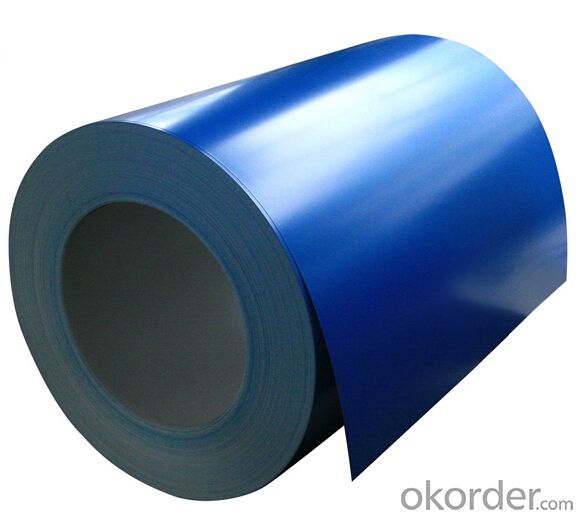
4.Pre-painted Aluzinc Steel Coils Specification:
Product Name | Galvanized Steel plate |
Thickness | 0.14mm-4.0mm |
Thickness Tolerance | +/-0.03mm |
Width | 600-1500mm |
Width Tolerance | +/-0.5mm |
Length | 1000-6000mm |
Zinc Coating | z60-z275 g/m2 |
Standard | ASTM, AISI, DIN, GB, BS, JIS |
Material | SGCC,DC51D,DX52D,DX53D,,SGCD,Q195,Q235,SGHC,DX54D, S350 GD, S450 GD,S550 GD |
Spangle | zero spangle, regular spangle or normal spangle, small spangle, big spangle |
Surface Treatment | Chromated and oiled, Chromated and non-oiled, Anti-finger, Dry, Bright |
5.FAQ
We have organized several common questions for our clients,may help you sincerely:
①How about your company?
A world class manufacturer & supplier of castings forging in carbon steel and alloy steel,is one of the large scale professional investment casting production bases in China,consisting of both casting foundry forging and machining factory. Annually more than 8000 tons Precision casting and forging parts are exported to markets in Europe,America and Japan. OEM casting and forging service available according to customer’s requirement.
②How to guarantee the quality of the products?
We have established the international advanced quality management system,every link from raw material to final product we have strict quality test;We resolutely put an end to unqualified products flowing into the market. At the same time, we will provide necessary follow-up service assurance.
③How long can we receive the product after purchase?
In the purchase of product within three working days, We will arrange the factory delivery as soon as possible. The pecific time of receiving is related to the state and position of customers.Commonly 7 to 10 working days can be served.
- Q: Consider a steel rod of diameter 4.5 mm and length 3.3 m. If a compressive force of 4900 N is applied to each end, what is the change in the length of the rod?
- You need to calculate the stress on the rod and compare this with the mechanical properties of the steel. It would help if you were given more info. You will need to know something about the steel such as the yeild stress and E, the modulus of elasticity. The value of E is about the same for a wide range of steels. So long as the applied stress is below the yield stress, the strain is all elastic and is calculated from E. The real answer is that you can not answer this question since you do not know what the temperature is. Given the applied load, the change in length will be much different at room temperature than at 1500C.
- Q: - I'm considering doing my physics coursework on the uses of Mild Steel in skyscrapers and construction, would this be right? Some sources tell me mild steel is too weak, others say it is fine
- Mild steel doesn't really mean anything, technically. In today's world all steel is mild steel unless it's high carbon or alloy, which are mostly tool steels. You'll need to study steel much deeper than that to accomplish any real physics work relating to steel.
- Q: I want to purchase steel for construction purpose, What aspects should I keep in mind while deciding that which company should I contact for this?
- I okorder /
- Q: My company want to welding stainless steel, do not know to use what welding machine?
- There are many ways in welding stainless steel, such as coating manual welding,argon arc welding, pulsed argon arc welding, MIG, pulsed MIG, double pulsed MIG. Different welding ways own their merits and faults and adaptive working conditions. It is recommended to choose pulsed MIG, its molding very good and efficiency high, so it is mainstream application for stainless steel welding. Now many digital welding machines can supply these welding methods at the same time. And their welding effects is far better than traditional machines. Among them, FRONIUS’s TPS series and Nebula series are representitive products.
- Q: I know aluminum is lighter but I'm looking at a 01 bianchi grizzly mountain bike which is steel. I used to ride a specialized stumpjumper m4 which was aluminum. It was quite light so I don't know if I'll like a bit heavier bike but overall what is better from those who have had both?
- Depending on the price, aluminum may be as heavy or heavier than steel... don't let anyone tell you otherwise. Keep in mind that with age aluminum will eventually break from stress while steel will never fail due solely to riding stresses. In all, it is up to you. I ride steel or magnesium road bikes and aluminum or magnesium MTBs.
- Q: What are the different types of steel coil edge condition options?
- There are several different types of steel coil edge condition options available, each with its own unique characteristics and advantages. Some of the most common types include: 1. Mill Edge: This is the most basic and common type of steel coil edge condition. It is produced during the hot rolling process and is characterized by a naturally rough and uneven edge. Mill edge coils are typically used for applications where the edge quality is not critical, such as in general fabrication. 2. Slit Edge: Slit edge coils are created by cutting the edges of the steel coil using a slitting machine. This process produces a smoother and more uniform edge compared to mill edge coils. Slit edge coils are often preferred for applications that require a higher level of precision, such as in automotive or electrical industries. 3. Trim Edge: Trim edge coils are similar to slit edge coils but with an additional trimming process to remove any defects or imperfections from the edges. This results in an even smoother and cleaner edge, making trim edge coils ideal for applications where appearance and aesthetic quality are important, such as in architectural or decorative purposes. 4. Deburred Edge: Deburred edge coils undergo a deburring process to remove any sharp or burr-like edges. This is done to ensure safety and prevent injury during handling or processing of the coils. Deburred edge coils are commonly used in industries where worker safety is a priority, such as in construction or manufacturing. 5. Rounded Edge: Rounded edge coils have their edges rounded off to eliminate any sharp corners or edges. This type of edge condition is often used in applications where the coils will come into contact with delicate materials or surfaces, as it helps to prevent scratching or damage. It is important to note that the choice of steel coil edge condition will depend on the specific requirements of the application and the desired outcome. Each type of edge condition offers its own unique benefits, and it is crucial to consider factors such as precision, appearance, safety, and functionality when selecting the appropriate option.
- Q: What are the different methods of levelling steel coils?
- Different methods are employed to level steel coils, depending on their specific requirements and applications. Some commonly used methods include: 1. Roller Leveling: This method utilizes a series of rollers to apply pressure on the steel coil, effectively reducing residual stresses and eliminating any waviness or curvature. It is commonly used for achieving high flatness in thinner gauge coils. 2. Stretch Leveling: In this method, the steel coil is stretched beyond its yield point to eliminate shape defects. The coil is subjected to tension in a stretcher leveler machine, which elongates the material and removes inherent stresses. It is often used for achieving greater flatness in thicker gauge coils. 3. Temper Milling: This method involves passing the steel coil through a temper mill equipped with work rolls on top and bottom. The temper mill applies tension to the coil, flattening it and improving its shape and surface quality. It is typically used for higher strength steel grades. 4. Corrective Leveling: When the steel coil exhibits significant shape defects like wavy edges or center buckles, corrective leveling is employed. This method selectively removes material from specific areas of the coil to achieve a flat and uniform surface. Laser or plasma cutting machines are often used for this process. 5. Tension Leveling: Similar to stretch leveling, tension leveling applies tension to the coil without exceeding its yield point. Bridle rolls are used to stretch the material, eliminating internal stresses and leveling the coil. It is commonly used for achieving flatness in higher strength and thinner gauge coils. These methods can be used individually or in combination, depending on the specific requirements and desired end product. Each method has its advantages and limitations, and the choice of leveling method depends on factors such as coil thickness, material properties, and desired flatness.
- Q: Please explain why steel is denser than wood.
- Steel is made up mostly of iron with a very small amount of carbon added. Iron is a metallic element with a high atomic number which means it's molecules contain lots of particles and consequently it is relatively heavy, or dense. Wood on the other hand is made up mostly of carbon which is a non-metallic element with a lower atomic number and fewer particles in each molecule, and consequently it is a lot lighter or less dense than steel.
- Q: Is it possible that stainless steel watches get rust. Any experience? Thanks.
- Stainless can oxidize over time but it doesn't look much like regular rust. Depending on the exact composition of the stainless alloy in question and what other materials are in contact with it, that's more or less of an issue. In constant contact with skin oils and gentle polishing from contact with skin and clothing, watches rarely rust regardless of what they're made of, I think you have nothing to worry about. Note: for future reference, bleach is absolute hell on stainless. It's bad enough on steel, worse on stainless. Especially because you have this idea that stainless is more or less impervious, when in reality it just isn't.
- Q: How are steel coils used in the manufacturing of automotive exhaust systems?
- Steel coils are used in the manufacturing of automotive exhaust systems as they are formed into specific shapes and sizes to create the necessary components, such as pipes, mufflers, and catalytic converters. The coils are precision-cut, welded, and bent to fit the design requirements and ensure efficient exhaust flow, durability, and resistance to high temperatures and corrosion.
Send your message to us
Pre-painted Aluzinc Steel Coils Color Coated for Wholesales
- Loading Port:
- Tianjin
- Payment Terms:
- TT OR LC
- Min Order Qty:
- 10 m.t.
- Supply Capability:
- 1000 m.t./month
OKorder Service Pledge
OKorder Financial Service
Similar products
Hot products
Hot Searches
Related keywords
